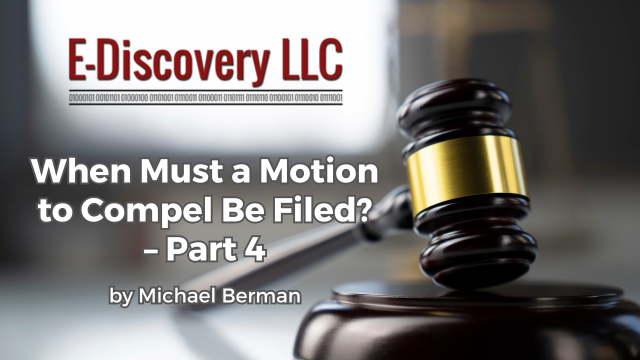
[EDRM Editor’s Note: The opinions and positions are those of Michael Berman.]
The Federal Rules of Civil Procedure do not state when a motion to compel must be filed. This silence has generated a number of discovery disputes. When Must a Motion to Compel Be Filed? (Aug. 26, 2024); When Must a Motion to Compel Be Filed? – Part 2; (Sep. 6, 2024); Half-Baked Motion to Compel Was Not Prompt, Not Ripe, Not Complete, and Not Likely to Succeed (Aug. 22, 2025)(Part 3).
The lack of clear milestones suggests the need for caution on the part of a party contemplating such a motion.
The timing issue arose again in Feit Electric Co., Inc. v. CFL Technologies, LLC, 2025 WL 2987084 (N.D. Ill. Oct. 22, 2025). The Magistrate Judge held that Feit Electric’s motion to compel was untimely and, upon consideration of Feit Electric’s objections, the District Judge agreed, overruling the objections: “The Court agrees… with [Magistrate] Judge McShain that, in the face of Feit Electric’s long-held objections to the requests, it is inexplicable that CFLT waited so long to seek judicial intervention.” Id. at *5.
In 2013, Feit sued for a declaration that a patent was unenforceable. A discovery dispute arose in 2018, when CFLT’s predecessor was dissatisfied with Feit Electric’s responses. However, discovery was stayed from June 2018 to July 1, 2021. The parties “re-engaged” in discovery from July 2021 to October 2022.
On October 7, 2022, CFLT filed a motion to compel. That was more than nine months after discovery re-opened; four months after a meet-and-confer to discuss discovery disputes; and, thirteen days before discovery closed. Feit Electric successfully contended that the motion was untimely.
In its unsuccessful objections, CFLT’s first argument was that “delay alone does not provide a basis to deny a motion to compel filed before the close of discovery.” Id. at *3. The court disagreed, writing:
Although the Federal Rules of Civil Procedure place no time limit on filing a motion to compel within the discovery period, courts [have] extremely broad discretion in controlling discovery…. A Court may exercise this discretion to deny a motion to compel as untimely.
Id. (cleaned up).
CFLT’s second argument was a challenge to the finding of untimely filing. The court wrote that: “District courts may deny motions brought within the discovery period as untimely … where there has been unexplained or undue delay or when the late motion will require an extension of the discovery period.” Id. at *3.
A court making that determination should “focus on three questions: (i) how long was the delay; (ii) was there an explanation for it; and (iii) what happened during the delay.” Id. (cleaned up). A court should exercise discretion and consider “the entire complex circumstances that give rise to the motion.” Id. It may excuse untimeliness where there is a “reasonable and persuasive justification….” Id.
Here:
[Magistrate] Judge McShain found CFLT’s Motion was untimely because (1) CFLT delayed pursuing resolution of the discovery disputes until nine-and-a-half months after discovery reopened; (2) CFLT delayed bringing the Motion until four months after a meet-and-confer with Feit Electric regarding the discovery disputes; and (3) granting the Motion would require reopening discovery.
Id.
On these facts: “The Court finds that CFLT failed to show that [Magistrate] Judge McShain’s rulings on these issues were clearly erroneous or contrary to law.”
The court wrote that: “The only explanation CFLT offers for the delay is that, during this time, they were pursuing other issues in the case.” Id. at *4. The court concluded that CFLT chose its own strategy and: “It is within a Court’s discretion to find undue delay where there were multiple months of discovery inaction and representations to the Court that no issues existed.” Id. at *4. It added that: “The excuse of an excessive workload is not sufficient to justify untimeliness.” Id. For a similar analysis, see Too Busy to Respond to Discovery = Waiver of Objections & Sanctions (Nov. 1, 2024).
The excuse of an excessive workload is not sufficient to justify untimeliness.
Feit Electric Co., Inc. v. CFL Technologies, LLC, 2025 WL 2987084 (N.D. Ill. Oct. 22, 2025).
However, the Feit Electric court noted that CFLT “asserts that it could not bring its Motion until it was clear that the parties had reached an impasse over the protective order and ESI protocol issues.” Id. at *4. The court held that this assertion did not “absolve[] the 2018 disputes” and “choosing to negotiate a protective order late in discovery was a strategic decision, and CFLT must endure the harsh results of this tactical decision.” Id. at *4 (cleaned up).
Because “Feit Electric consistently maintained its objections to the 2018 discovery requests, yet CFLT did not file its Motion to Compel until four months after the meet-and-confer and thirteen days before the close of discovery,” and CFLT offered no other explanations, there was no error in the untimeliness holding. Id. at *5.
Finally, the Feit Electric court held that it was not error for the Magistrate Judge to refuse to extend the discovery deadline to permit this motion: “Courts have deemed a motion to compel brought close to the close of discovery as untimely where the discovery requested in the motion could not be completed before the discovery deadline and there was no good cause to extend the deadline.” Id. at *5.
The rules are also silent when it comes to the time to file a spoliation motion. That silence has led to litigation. The “Best Time” to File a Spoliation Motion (Jul. 15, 2025)(and blogs cited therein), citing, e.g., Goodman v. Praxair, 632 F.Supp.2d 494, 508 (D. Md. 2009)(Grimm, J.), and M. Berman, et al., eds., “Electronically Stored Information in Maryland Courts” (Md. State Bar Ass’n. 2020), 229.
Of course, given varying approaches, it is important to research the case law and local rules in each jurisdiction. Id. For example, Groves Inc. v. R.C. Bremer Marketing Associates, 2024 WL 4871368, at n. 2 (N.D. Ill. Sep. 22, 2024), states in the spoliation context that the timing outcome may vary with “the judge who decides the motion” and suggests that briefing be “tailor[ed] to the particular judge before whom” the lawyers will argue.
The dilemma may be described as a Goldilocks problem. Like a motion for sanctions, a motion to compel must be neither too early nor too late. Half-Baked Motion to Compel Was Not Prompt, Not Ripe, Not Complete, and Not Likely to Succeed (Aug. 22, 2025).
Like a motion for sanctions, a motion to compel must be neither too early nor too late.
Michael Berman, E-Discovery LLC.
In the context of spoliation motions, the Groves court wrote that “litigation is not high tea at the Savoy….” It suggested raising the timing issue with opposing counsel, discussing it, and notifying the court.
However, there is an alternative that I suggest may be preferable. Another mechanism for discussion might be in connection with a discovery plan or ESI Protocol. See “ESI Protocol” v. “Discovery Plan” (Jan. 2, 2024); Fed.R.Civ.P. 26(f). Parties could agree and submit a Fed.R.Civ.P. 29 stipulation stating when a motion to compel must be filed. One advantage of this approach is that a discussion could be had well in advance of a “declaration of war.”
Assisted by GAI and LLM Technologies per EDRM GAI and LLM Policy.


